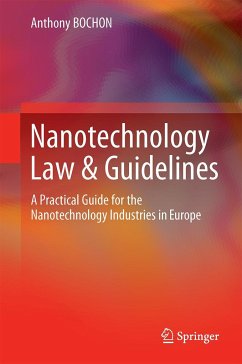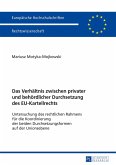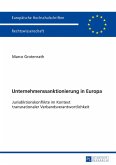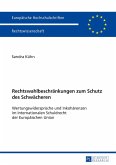The book is a concise guideline to different issues of nanotechnology in the European Legislation.- It offers an extensive review of all European Patent Office (EPO) cases on nanotechnological inventions. The challenge for new nanotechnology patents is to determine how patent criteria could be met in a patent application. This book shows how to identify the approach and the ways to cope with this challenge.- It extensively reviews trademark cases at the EU level and an in-depth perspective on competition law and state aid law (mergers, essential facilities licenses, public funding).- The books presents the original corporate, tax and finance approach within the current EU legal framework - It gives practical tips to cope with currently existing legislation: the books is not limited to an overview of applicable legislation. E.g.: how to deal with the risk defence under the product liability directive (implemented in 25 out of 27 EU member states) or how to deal with the chemical agents directive and adopt internal policies for nanoparticules.- It proposes many examples of contract clauses or advertising texts which would be appropriate to market products containing nanotechnologies - The books focusses on marketing aspects such as advertising, codes of conduct and import/export regulations.
This book presents concise guidelines on different issues concerning nanotechnology in European legislation and offers an extensive review of all European Patent Office (EPO) cases on nanotechnological inventions. The challenge for new nanotechnology patents is to determine how patent criteria can be met in the patent application. The book shows how to identify suitable approaches to and the ways of overcoming this challenge. It extensively reviews trademark cases at the EU level and provides an in-depth perspective on competition law and state aid law (mergers, essential facilities licenses, public funding). It also presents an original corporate, tax and finance approach within the current EU legal framework.
Not limited to an overview of applicable legislation, it offers practical tips on how to cope with the current legislation, e.g. how to deal with the risk defence under the product liability directive (implemented in 25 out of 28 EU member states); or how todeal with the chemical agents directive and adopt internal policies for nanoparticles. It also examines numerous examples of contract clauses and advertising texts that would be appropriate for marketing products involving nanotechnologies. Lastly, the book considers marketing aspects such as advertising, codes of conduct and import/export regulations.
This book presents concise guidelines on different issues concerning nanotechnology in European legislation and offers an extensive review of all European Patent Office (EPO) cases on nanotechnological inventions. The challenge for new nanotechnology patents is to determine how patent criteria can be met in the patent application. The book shows how to identify suitable approaches to and the ways of overcoming this challenge. It extensively reviews trademark cases at the EU level and provides an in-depth perspective on competition law and state aid law (mergers, essential facilities licenses, public funding). It also presents an original corporate, tax and finance approach within the current EU legal framework.
Not limited to an overview of applicable legislation, it offers practical tips on how to cope with the current legislation, e.g. how to deal with the risk defence under the product liability directive (implemented in 25 out of 28 EU member states); or how todeal with the chemical agents directive and adopt internal policies for nanoparticles. It also examines numerous examples of contract clauses and advertising texts that would be appropriate for marketing products involving nanotechnologies. Lastly, the book considers marketing aspects such as advertising, codes of conduct and import/export regulations.








